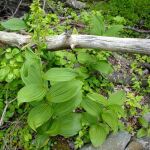| Common Name: |
Indian Poke |
| Other Names: |
Green Hellebore, American Hellebore |
| Botanical Name: |
Veratrum viride |
| Genus: |
Veratrum |
| Family: |
Melanthiaceae |
| Native Location: |
Easterm N America |
| Cultivation: |
Rich, moist, well-drained soil in partial shade. |
| Propagation: |
By seed sown when ripe; by division in autumn or early spring. |
| Harvest: |
Roots are collected in autumn and dried for fluid extracts and powder, and also or the extraction of alkaloids. |
| Height: |
2m (6ft) |
| Width: |
60cm (24in) |
| Hardiness: |
Z3-8 |
| Parts Used: |
Roots and Rhizomes |
| Properties: |
An emetic, cathartic herb that causes sneezing and lowers blood pressure. It is insecticidal. |
| Medicinal Uses: |
Formerly used internally for pneumonia, peritonitis, arteriosclerosis, and hypertension associated with toxemia in pregnancy. Externally as a parasiticide for head lice; also in veterinary medicine to destroy parasites. Rarely used now. |
| Warning: |
All parts are highly toxic if ingested.
Contact with foliage may cause skin irritation.
Prolonged handling may cause systemic poisoning.
Excess causes diarrhea and vomiting with severe retching, shallow breathing, pallor, perspiration, and potentially fatal collapse. For use by qualified practitioners only. |
| Bibliography: |
Encylopedia of Herbs by Deni Brown Copyright ©: 1995, 2001 Dorling Kindersley Limited pps. 400-401
|

